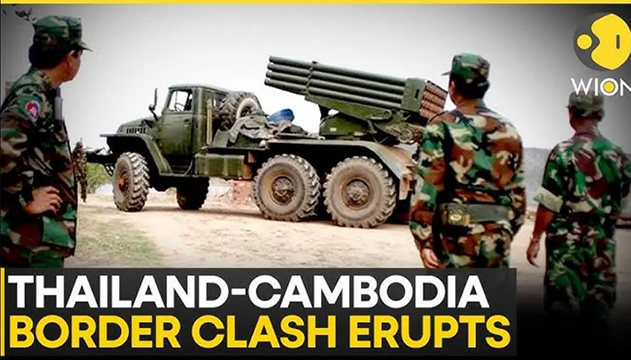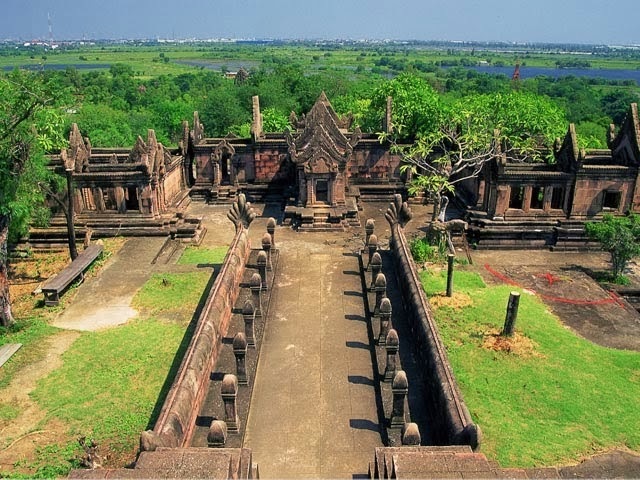
A deadly flare-up along the Thailand-Cambodia border has reignited tensions between the two Southeast Asian neighbors, with clashes on Thursday claiming at least 11 lives — mostly civilians. The confrontation, which involved small arms, artillery, rockets, and even airstrikes, marks one of the most serious escalations in years, ‘India Times’ reports.
Fighting reportedly broke out in at least six locations along the 800-kilometer border, according to Thai Defense Ministry spokesperson Surasant Kongsiri. The immediate spark was a landmine explosion on Wednesday that injured five Thai soldiers. In response, Thailand expelled Cambodia’s ambassador and recalled its own from Phnom Penh.
The Thai government has since sealed all land border crossings and advised its citizens to leave Cambodia.
Tensions over the disputed frontier have simmered for decades, often erupting into brief skirmishes. However, the latest round of violence — larger in scale and intensity — has stoked fears of broader conflict. Thursday’s clashes began near the ancient Ta Muen Thom temple, close to Thailand’s Surin province and Cambodia’s Oddar Meanchey province.
The Thai army claimed it detected a drone shortly before spotting six armed Cambodian soldiers approaching its border post. Thai troops allegedly tried to defuse the situation by shouting warnings, but were met with gunfire. Cambodia, however, blamed Thailand for initiating the attack, accusing Thai forces of violating its territorial sovereignty and deploying drones first.
The Thai military later launched airstrikes on what it described as military targets inside Cambodia. Cambodia’s Defense Ministry claimed Thai jets dropped bombs near the historic Preah Vihear temple, a flashpoint in the long-standing border dispute.
Prasat Preah Vihear: Sacred Site Turned Battlefield
At the center of this decades-old dispute lies Prasat Preah Vihear, an 11th-century Hindu temple dedicated to Lord Shiva. Perched on a cliff in Cambodia’s Preah Vihear province, the temple offers a commanding view of the Cambodian plains — and a politically sensitive location near the border with Thailand.
Built by the Khmer Empire, the temple's location became contentious following the end of French colonial rule in 1953. The boundary drawn during the colonial era placed the temple in Cambodian territory — a point Thailand has repeatedly disputed.
In 1962, the International Court of Justice (ICJ) ruled that the temple belongs to Cambodia. The ruling temporarily settled the issue until 2008, when the site was designated a UNESCO World Heritage Site — prompting renewed hostilities. Another ICJ ruling in 2011 reaffirmed Cambodia’s ownership.
 Preah Vihear is a region in the very north of Cambodia, where the eponymous temple complex of Prasat Preah Vihear is located. The temple directly adjoins the Thai border. The area has been the site of a border conflict between Cambodia and Thailand since the 1950s, with both nations claiming the temple complex and surrounding areas.
Preah Vihear is a region in the very north of Cambodia, where the eponymous temple complex of Prasat Preah Vihear is located. The temple directly adjoins the Thai border. The area has been the site of a border conflict between Cambodia and Thailand since the 1950s, with both nations claiming the temple complex and surrounding areas.
Photo: siem-reap.de
According to UNESCO, “Situated on the edge of a plateau that dominates the plain of Cambodia, the Temple of Preah Vihear is dedicated to Shiva. The temple comprises a series of sanctuaries connected by pavements and staircases along an 800-meter-long axis, dating back to the first half of the 11th century. Its origins, however, trace back to the 9th century. The site stands out for its architectural brilliance, harmonious integration with the landscape, and intricately carved stonework.”
Despite its spiritual and cultural significance, Prasat Preah Vihear remains a geopolitical tinderbox — where history, religion, and nationalism continue to clash.
read more in our Telegram-channel https://t.me/The_International_Affairs

 9:59 26.07.2025 •
9:59 26.07.2025 •






















